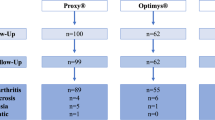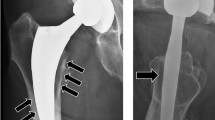Abstract
Purpose
The trabecular-orientated bionic hip stem was designed to mimic the natural force transmission through the femur in total hip arthroplasty, resulting in supposedly longer prosthesis survivability. The aim of this study was to compare the second-generation bionic hip stem to a standard uncemented hip stem.
Methods
A group of 18 patients (21 hips) who underwent total hip arthroplasty with a bionic stem (bionic group) was compared with a historic group of 12 patients (12 hips) treated with standard anatomic hip stem (control group). During the first year after the procedure, the densitometric measurements of the bone around the prosthesis were taken. Radiographic and clinical assessments were additionally performed preoperatively and at the three month, six month, one year and three year follow-ups in the bionic group.
Results
In the bionic group, one patient was revised for aseptic loosening and 16 patients (19 hips) were available to the final follow-up. A significant decrease of bone mineral density was found in Gruen zones 3, 4 and 5 in the bionic group, and in zone 7 in both groups. The bionic group had a significantly higher bone mineral density in Gruen zone 1 at the one year follow-up. At the final follow-up, all prostheses were radiologically stable in both groups.
Conclusions
Provided that a good implant position is achieved, comparable short-term results can be obtained using a bionic stem. Still, a decrease of bone mineral density in Gruen zone 7 occurred in both groups. Further studies are required to determine survivability of the bionic stem.





Similar content being viewed by others
References
Grochola LF, Habermann B, Mastrodomenico N, Kurth A (2008) Comparison of periprosthetic bone remodeling after implantation of anatomic and straight stem prostheses in total hip arthroplasty. Arch Orthop Trauma Surg 128:383–392
Rahmy AI, Gosens T, Blake GM, Tonino A, Fogelman I (2004) Periprosthetic bone remodeling of two types of uncemented femoral implant with proximal hydroxyapatite coating: a 3-year follow up study addressing the influence of prosthesis design and preoperative bone density on periprosthetic bone loss. Osteoporos Int 15:281–289
Nysted M, Benum P, Klaksvik J, Foss O, Aamodt A (2011) Periprosthetic bone loss after insertion of an uncemented, customized femoral stem and an uncemented anatomical stem. A randomized DXA study with 5-year follow-up. Acta Orthop 82:410–416. doi:10.3109/17453674.2011.588860
Karachalios T, Tsatsaronis C, Efraimis G, Papadelis P, Lyritis G, Diakoumopoulos G (2004) The long-term clinical relevance of calcar atrophy caused by stress shielding in total hip arthroplasty: a 10-year, prospective, randomized study. J Arthroplasty 19:469–475
Mavrogenis AF, Dimitriou R, Parvizi J, Babis GC (2009) Biology of implant osseointegration. J Musculoskelet Neuronal Interact 9:61–71
Knusten AR, Ebramzadeh E, Longjohn DB, Sangiorgio SN (2014) Systematic analysis of bisphosphonate intervention on periprosthetic BMD as a function of stem design. J Arthroplasty 29:1292–1297. doi:10.1016/j.arth.2014.01.015
Copf F, Holz U, Vesel S (1983) Eine biomechanische Lösung zur dauerhaften Verankerung künstlicher Hüftgelenkspfannen. Z Orthop Unfall 121:265–270
Copf F, Czarnetzki A (1989) Two-membrane system in the caput femoris and the distal femoral condyles. Acta Anat (Basel) 136:255–256
Copf F, Holz U (1991) Das in der Spongiosastruktur verankerte Hüftgeleks-Endoprothesen-Sistem. Akt Chir 26:301–308
Argyzis J, Faust G, Laxander A (1994) Biomechanishe Grundlagen. In: Copf F, Holz U (eds) Knochen als dynammisches Prinzip. Thieme Verlag, Stuttgart, pp 34–36
Wirth T, Syed Ali MM, Wilke A, Griss P (2000) Loosening of a fenestrated femoral prosthesis: a case report with histomorphologic analysis. J Arthroplasty 15:802–805
Marchetti ME, Steinberg GG, Greene JM, Jenis LG, Baran DT (1996) A prospective study of proximal femur bone mass following cemented and uncemented hip arthroplasty. J Bone Miner Res 11:1033–1039
Brodner W, Bitzan P, Lomoschitz F, Krepler P, Jankovsky R, Lehr S, Kainberger F, Gottsauner-Wolf F (2004) Changes in bone mineral density in the proximal femur after cementless total hip arthroplasty. A five-year longitudinal study. J Bone Joint Surg (Br) 86:20–26
Jahnke A, Engl S, Altmeyer C, Jakubowitz E, Seeger JB, Rickert M, Ishaque BA (2014) Changes of periprosthetic bone density after a cementless short hip stem: clinical and radiological analysis. Int Orthop 38(10):2045–2050. doi:10.1007/s00264-014-2370-6
Gruen TA, McNeice GM, Amstutz HC (1979) “Modes of failure” of cemented stem-type femoral components: a radiographic analysis of loosening. Clin Orthop Relat Res 141:17–27
Oh I, Harris WH (1978) Proximal strain distribution in the loaded femur. An in vitro comparison of the distributions in the intact femur and after insertion of different hip-replacement femoral components. J Bone Joint Surg Am 60:75–85
Johnston RC, Fitzgerald RH Jr, Harris WH, Poss R, Müller ME, Sledge CB (1990) Clinical and radiographic evaluation of total hip replacement. A standard system of terminology for reporting results. J Bone Joint Surg Am 72:161–168
Kobayashi A, Donnelly WJ, Scott G, Freeman MA (1997) Early radiological observations may predict the long-term survival of femoral hip prostheses. J Bone Joint Surg (Br) 79:583–589
Venesmaa PK, Kröger HP, Miettinen HJ, Jurvelin JS, Suomalainen OT, Alhava EM (2001) Monitoring of periprosthetic BMD after uncemented total hip arthroplasty with dual-energy X-ray absorptiometry—a 3-year follow-up study. J Bone Miner Res 16:1056–1061
Bishop NE, Burton A, Maheson M, Morlock MM (2010) Biomechanics of short hip endoprostheses-the risk of bone failure increases with decreasing implant size. Clin Biomech (Bristol, Avon) 25:666–674. doi:10.1016/j.clinbiomech.2010.04.013
Hamadouche M, Jahnke A, Scemama C, Ishaque BA, Rickert M, Kerboull L, Jakubowitz E (2014) Length of clinically proven cemented hip stems: State of the art or subject to improvement? Int Orthop. doi:10.1007/s00264-014-2522-8
Martini F, Schmidt B, Sell S (1997) Validity and reproducibility of osteodensitometric DEXA-measurements following total hip endoprosthesis. Z Orthop Ihre Grenzgeb 135:35–39
Kim YH, Kim JS, Joo JH, Park JW (2012) A prospective short-term outcome study of a short metaphyseal fitting total hip arthroplasty. J Arthroplasty 27:88–94. doi:10.1016/j.arth.2011.02.008
Conflict of interest
The authors declare that they have no conflict of interest.
Author information
Authors and Affiliations
Corresponding author
Rights and permissions
About this article
Cite this article
Fokter, S.K., Sarler, T., Strahovnik, A. et al. Results of total hip arthroplasty using a bionic hip stem. International Orthopaedics (SICOT) 39, 1065–1071 (2015). https://doi.org/10.1007/s00264-014-2623-4
Received:
Accepted:
Published:
Issue Date:
DOI: https://doi.org/10.1007/s00264-014-2623-4




